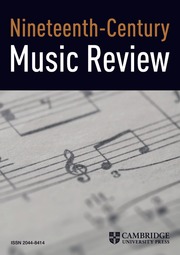No CrossRef data available.
Article contents
Moniuszko and the Revival of the Noble Traditions: The Countess and The Haunted Manor
Review products
Published online by Cambridge University Press: 29 September 2023
Extract
The two recently recorded CD sets of Hrabina (The Countess) and Straszny dwór (The Haunted Manor) in complete concert versions with eighteenth-century instruments add enormously to the Polish operatic repertoire in the nineteenth century, and offer a fresh listening experience for those who have long wished for first-rate recordings of lesser-known, yet brilliantly executed, works of the hitherto neglected composer, Stanisław Moniuszko (1819–1872). Born in the Minsk district of modern Belarus, Monisuzko was gentry, and his nostalgia for the customs, the fields and forest, and the rural community that shaped his childhood years, fuelled his enthusiasm for modern operas set in the eighteenth century. These stellar concert versions of The Countess and The Haunted Manor provide a fascinating glimpse into the provocative and glittering salons of the eighteenth-century Warsaw nobility, whose inhabitants stand firmly in contrast to the more modest and self-effacing life of the peasants and the country gentry. In both operas Moniuszko successfully provides a romanticized portrayal of pre-Partition courtly life in Poland. While these two operas were highly regarded as national treasures in Poland, they were not particularly well known outside of the country. Polish opera at that time was largely overshadowed by Italian, French, and German composers, and the nation's subjugation to the Hapsburgs, Prussians, and Russians throughout the nineteenth century contributed mightily to the neglect of staged works by Polish composers. Additionally, singers needed to be trained in the nuances and inflections of the language. Prior recordings were either incomplete or were not available with English translations of the librettos. With the Biondi and Nowak recordings, Moniuszko's vision of expanding his art to a global audience has finally been achieved. These recordings are accessible to all opera enthusiasts on an international playing field.
- Type
- Review Essay
- Information
- Copyright
- Copyright © The Author(s), 2023. Published by Cambridge University Press
References
1 For further reference and scholarly insights into Moniuszko's life and his contributions to the repertoire at the Teatr Wielki in Warsaw, see Rüdiger Ritter's recent biography, Der Tröster der Nation: Stanisław Moniuszko (1819–1872) und seine Musik (Wiesbaden: Harrassowitz, 2019; Phillip Ther's cultural study, Center Stage: Operatic Culture and Nation Building in Nineteenth-Century Central Europe (West Lafayette: Purdue University Press, 2014); and Józef Szczublewski's pioneering work, Teatr Wielki w Warszawie 1833–1993, in collaboration with Teresa Kilian (Warsaw: Państwowy Institut Wydawniczy, 1993).
2 Tygodnik Peterburgski, 22 September 1842, 495. Tygodnik Peterburgski, a twice-weekly periodical published in St Petersburg in the Polish language, was published approximately 1830–1859. It included essays and advertisements from literary figures and composers, including Moniuszko. Several first editions of Monisuzko's songs are survive in the St Petersburg Rimsky-Korsakov State Conservatory Archives, but no dates are given for the publication. These include Drugi Śpiewnik Domowy St. Moniuszki (Vilnius: Nakładem Józefa Zawadzkiego, no date given): pl. no. J. 957, 1–42; Czwarty Śpiewnik Domowy St. Moniuszki (Vilnius: Nakładem Józefa Zawadzkiego, no date given): pl. no. J 10 Z, 1–58; Piąty Śpiewnik Domowy St. Moniuszki (Vilnius: Nakładem Józefa Zawadzkiego, no date given): pl.no. J 10 Z, 1–75; Piosnki Sielskie Władysława Syrokomli. Z Kantaty: Rok w Piesni. St. Moniuszki (Vilnius: Nakładem Józefa Zawadzkiego, no date given): pl. no. J 957 Z, 59–70.
3 Journal de St.-Pétersbourg, 30 January 1845, no. 860, 3442.
4 Tygodnik Peterburgski, 22 September 1842, 495.
5 See https://teatrwielki.pl/en/ (accessed 8 August 2023).
6 For additional sources on traditional Polish dances, see Czekanowska, Anna's study, Slavonic Heritage, Polish Tradition, Contemporary Trends (Cambridge: Cambridge University Press, 1990)Google Scholar; and Timothy Cooley, J., Making Music in the Polish Tatras: Tourists, Ethnographers, and Mountain Musicians (Bloomington: Indiana University Press, 2005)Google Scholar.
7 Włodzimierz Wolski provided the libretto for Halka and the successful premiere of the revised 1858 version brought Moniuszko to the forefront of musical activity in Warsaw. He accepted a position as director of the Teatr Wielki soon thereafter, and worked ceaselessly to bring Polish opera to the general public. Halka is based on Kazimierz Wójcicki's story, Góralka (The Highland Girl), from his collection of tales titled Stary gawędyiii i obrazy (Old pictures and legends). The narrative embraces a musical portrayal of social conflict between the traditions of the Polish nobles and those of the mountaineers. The plot was considered scandalous for its time: a young nobleman breaks his promise of marriage to a peasant girl who has given birth to his child and instead chooses to marry the daughter of a local nobleman. Here the opera's conflict was two-fold: first, a betrayal of the moral code of the mountaineer community, and second, the unflattering depiction of the nobility. Despite the extensive revisions, the revised version of Halka premiered in Italian translation, rather than in the original Polish, due to the strict censorship of operas sung in Polish in the public theatres.
8 Tygodnik Peterburgski, 22 September 1842, 495.


